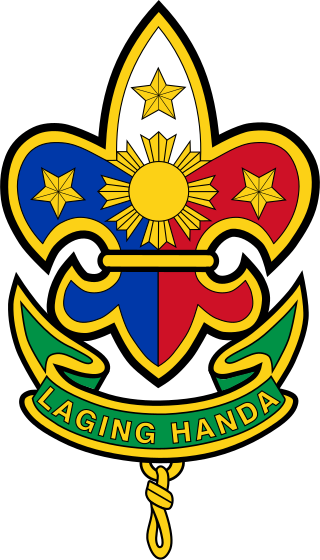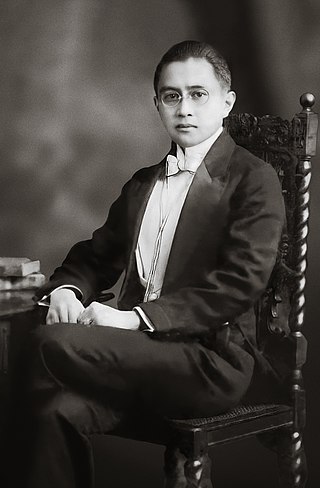
The Boy Scouts of the Philippines (BSP) is the national scouting organization of the Philippines in the World Organization of the Scout Movement. The Scout movement was first introduced in the Philippines in 1910 during the American Occupation. It was granted "Recognition as a Member Organization of the Boy Scouts International Conference with effect from October 31, 1936" by virtue of certification signed by J. S. Wilson, Olave Baden-Powell, and Daniel Spry.

Josephus Hamilton Stevenot was an American entrepreneur and U.S. Army officer in the Philippines with many accomplishments, but today mostly remembered in the Boy Scouts of the Philippines as a co-founder.

Lorenzo Ruiz, also called Saint Lorenzo of Manila, was a Filipino Catholic layman and a member of the Third Order of Saint Dominic. A Chinese Filipino, he became his country's protomartyr after his execution in Japan by the Tokugawa shogunate during its persecution of Japanese Christians in the 17th century. Lorenzo Ruiz is the patron saint of, among others, the Philippines and the Filipino people.

Jorge Bartolomé Vargas y Celis was a Filipino lawyer, diplomat and youth advocate born in Bago, Negros Occidental, Philippines. He graduated valedictorian from Negros Occidental High School in 1909 and obtained a Bachelor of Arts degree in 1911 and a Bachelor of Law degree with honors in 1914, both from the University of the Philippines. He was a founding member of the Philippine Amateur Athletic Federation in 1911 and served in its executive committee in 1918. He served as its second chairman from 1935 to 1955. He was also the first Filipino member of the International Olympic Committee.

Don Gabriel Amando Daza, KGCR, KC*SS was the first Filipino electrical engineer and one of the charter members of the Boy Scouts of the Philippines (BSP). He co-founded the Philippine Long Distance Telephone Company (PLDT), Philippine Telegraph and Telephone Co. (PT&T), Philippine Electric Manufacturing Company (PEMCO), Phelps Dodge Philippines. He was the supervising engineer and assistant general manager of Visayan Electric Company (VECO) and led its expansion out of Cebu City. President and chief scout of the BSP in 1961–68. In 1945, President Osmeña appointed Daza to be a member of the board of directors of the Manila Railroad Company and the Philippine Charity Sweepstakes Office. In 1950, he was vice-chairman of the National Power Corporation and on the board of directors of the Manila Hotel Company. In 1951, Daza was appointed by President Quirino as a founding member of the board of directors of the National Shipyard and Steel Corporation. President and director of the National Economic Protection Agency (NEPA) in 1956.

The Manila North Cemetery is one of the oldest cemeteries in Metro Manila, Philippines. The cemetery is owned by and located in the City of Manila, the national capital, and is one of the largest in the metropolis at 54 hectares. It is located alongside Andrés Bonifacio Avenue and borders two other important cemeteries: the La Loma Cemetery and the Manila Chinese Cemetery. Numerous impoverished families notably inhabit some of the mausoleums.

Juan Felipe de Jesús Nakpil, KGCR, KSS known as Juan Nakpil, was a Filipino architect, teacher and a community leader. In 1973, he was named one of the National Artists for architecture. He was regarded as the Dean of Filipino Architects.

The Silver World Award is a distinguished service award of the Boy Scouts of America (BSA). It is presented for noteworthy and extraordinary service to youth on an international basis. Recipients must be a citizen of a country with a Scouting program that is a member of the World Scout Conference. Registered members of the BSA are not eligible for this award.
Dr. José María Delgado was the first Philippine Ambassador to the Vatican. He was the cousin of Francisco Afan Delgado, descendant of General Martín Teófilo Delgado.
Cecilio Kapirig Putong was a Filipino scholar, educator, writer, UNESCO fellow, author. In 1952, he became the Secretary of Education of the Philippines. He was one of the most brilliant minds from Bohol having a reported IQ of 138 based on Otis Intelligence Scale Test.

United Arab Airlines Flight 869 was an international scheduled passenger de Havilland Comet 4C flight from Tokyo, Japan, to Cairo via Hong Kong, Bangkok, Bombay and Bahrain. On 28 July 1963 it was being operated by a de Havilland Comet registered as SU-ALD, when on approach to Bombay's Santa Cruz Airport it crashed into the Arabian Sea off Bombay on 28 July 1963 with the loss of all 63 passengers and crew on board. Among the 55 passengers was the Philippine delegation of 24 Boy Scouts and adults traveling to the 11th World Scout Jamboree in Greece.

Holy See–Philippines relations refers to the relations between the Holy See and the Philippines. As one of two Catholic-majority countries in Asia, the Philippines enjoys significant relations with the Holy See. The Holy See has a nunciature in Manila, and the Philippines has an embassy to the Holy See based in Rome.
Various organizations have promoted Scouting activities in the Philippines: the YMCA, the Boy Scouts of America, the Camp Fire Girls, the Boy Scouts of the Philippines, the Girl Scouts of the Philippines, and the Boy Scouts of China.
The Philippine Council was founded in 1923 by the Rotary Club of Manila to organize Scouting activities in the Philippines. The founding/charter members were all prominent figures in the commercial, political, social, and cultural scene of Manila. Most held simultaneous memberships in a number of organizations, such as the YMCA, the American Chamber of Commerce of the Philippine Islands, the Masons, the Elks, the Army and Navy Club, etc. The Council was disbanded when the Boy Scouts of the Philippines was inaugurated in 1938.

The 11th World Scout Jamboree Memorial Rotonda is a roundabout in Quezon City, Metro Manila, Philippines. Located at the intersection between Timog and Tomas Morato Avenues, it serves as the boundary between barangays South Triangle, Laging Handa and Sacred Heart.

Arsenio Nicasio Luz y Katigbak was a Filipino showman, businessman, journalist and educator, remembered for being the General-Director of the Philippine Carnival which ran the Manila Carnival. He was an attaché for several Philippine Independence Missions to the U.S. as the representative of the press. He led trade negotiations during the transition to the Commonwealth and served as President Manuel L. Quezon's economic advisor at Malacañang throughout the Commonwealth Period. He was a charter member of the Boy Scouts of the Philippines and the first Filipino President of the Rotary Club of Manila. He was manager of the Philippine Government Commercial Agency's New York branch and represented the Philippines at several conventions and expositions.

The Embassy of the Philippines to the Holy See is the diplomatic mission of the Republic of the Philippines to the Holy See, the central government of Vatican City and the Roman Catholic Church. Opened in 1957, it is located along Via Paolo VI in the rione of Borgo, part of Municipio I in central Rome along the border between Italy and Vatican City, and across from St. Peter's Square.












